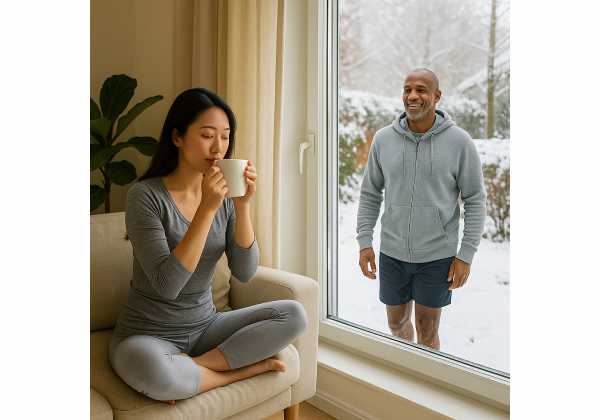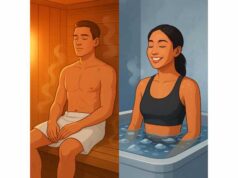
Cold can sharpen attention within minutes and, over weeks, make your body better at producing its own heat. The key is dose: small, repeatable exposures that teach your system to adapt rather than fight. You do not need ice baths or viral “challenges.” A cooler shower finish, a brisk walk without extra layers, or a short breath practice can deliver most of the benefit while keeping risk low. This guide lays out why cold can help, how to start, and how to progress with confidence. It also shows you how to pair cold with movement, who should go slow or avoid certain methods, and what to track so you actually stick with it. For a simple overview of how cold fits into cellular maintenance—autophagy, mitochondria, mTOR, and AMPK—see our summary of cellular stress and longevity pathways.
Table of Contents
- Why Cold Can Help: Alertness, Brown Fat, and Resilience
- Start Here: Cooler Showers, Short Exposures, and Breathing
- Progressions: Time, Temperature, and Frequency
- Pairing with Movement: Walks, Yoga, and Easy Cardio
- Contraindications and When to Skip Cold Work
- What to Track: Sleep, Mood, and Energy After Sessions
- Seasonal Adjustments and Travel Tips
Why Cold Can Help: Alertness, Brown Fat, and Resilience
Cold exposure is not about grit points. It is a training signal. When you cool the skin and drop core temperature slightly, several coordinated responses kick in:
- Immediate alertness. Brief cold stimulates noradrenaline and raises heart rate variability in ways many people experience as a clean, steady “wake-up.” The effect lands within minutes and fades gently, making it useful before focused work or a low-intensity workout.
- Thermogenic practice. With repetition, your body gets better at non-shivering thermogenesis—producing heat without muscular shaking. That shift is partly due to increased activity in brown adipose tissue (brown fat), which burns fuel to make heat. Over two to four weeks of gentle acclimation, people often notice less “sting” at a given temperature and faster rewarming afterward.
- Metabolic flexibility. Better cold tolerance is linked to more efficient fuel switching. As you adapt, you tend to rely a bit more on fat oxidation in the cold and recover heat faster after you finish the exposure.
- Vascular tone and comfort in winter. Repeated mild cold trains your blood vessels to constrict and dilate more effectively, which helps you feel warmer in cool environments and may reduce the urge to overdress indoors.
- Mood and stress buffering. Short cold bouts can replace mental rumination with a crisp, embodied focus. For some, that translates into a steadier mood and lower stress reactivity across the day.
Three principles keep this helpful rather than harsh:
- Signal, not suffering. Stop well before you shiver hard or feel panicky. Cold should feel challenging but controllable.
- Consistency over heroics. Two to five brief exposures per week beat occasional extreme plunges.
- Respect context. Cold directly after heavy lifting can blunt muscle-building signals. If strength or hypertrophy is a priority, separate cold from those sessions by several hours (details in Section 4).
Cold is a tool, not a test. Used thoughtfully, it can improve comfort, energy, and resilience without derailing recovery.
Start Here: Cooler Showers, Short Exposures, and Breathing
A good start feels almost underwhelming. You should finish warm within minutes, sleep normally that night, and want to repeat it. Use these steps for your first two to three weeks.
Week 1: Familiarization (3–4 sessions)
- Finish cool. End your regular shower with 30–60 seconds slightly cooler than comfortable. Keep the water moving around your torso, then arms and legs.
- Breathe low and slow. Aim for 4–6 breaths per minute (e.g., inhale 4 seconds, exhale 6 seconds). If you start to gasp, slow the flow even more; panic breathing makes cold feel harsher than it is.
- Rewarm on purpose. Dry briskly and put on warm layers. Sip a hot drink or do 1–2 minutes of easy air squats and arm swings.
- Stop points. End sooner if you have chest pain, dizziness, numb fingertips, or a strong “get-out” urge that does not settle within 10–15 seconds.
Week 2: Make it a habit (3–5 sessions)
- Extend the finish to 60–90 seconds, still at a modestly cool setting.
- Try a standalone cold moment on a non-shower day: open a window, step onto a balcony, or walk outside in light layers for 5–10 minutes. Keep movement easy and breathe through your nose.
Optional: First short immersion
If you have access to a cool pool or tub, start with 10–15°C (or the coldest you can control) for 30–60 seconds submerged to mid-chest. Keep your hands out if they are very sensitive. Exit, rewarm, and check how you feel for the next few hours and at bedtime.
Practical guardrails
- Eat normally and stay hydrated on cold days.
- Place sessions earlier in the day if you notice any sleep disruption.
- Keep cold far from heavy lifting. If you did a hard strength session, skip cold for 4–6 hours or move it to the next day.
A simple decision rule
The exposure was a good dose if: you rewarm within 15 minutes, your mood is steady, and you wake refreshed the next morning. If you feel wired, chilled for hours, or sleep poorly, halve the dose next time.
For a plain-language review of benefits, myths, and safety, skim our overview of cold exposure safety.
Progressions: Time, Temperature, and Frequency
Once the cool finish or short outdoor bouts feel routine, you can advance one variable at a time. Think in small steps.
Variables you can adjust
- Time: most people do well in the 1–3 minute range for showers and 1–5 minutes for brief immersions.
- Temperature: nudging the water a little colder or choosing a windier route has a strong effect. A 2–3°C drop can feel like a big step.
- Frequency: two to five sessions weekly is a useful band. More is not necessarily better; aim for 1–2 easy days each week without any deliberate cold.
A four-week, low-stress progression
- Week A: 60–90 s cool finish, 3–4 days/week. One easy outdoor “cool walk” (10 min).
- Week B: 90–120 s finish, 4–5 days/week. Optionally add a 60–90 s tub/immersion once.
- Week C: Maintain Week B and make one exposure slightly cooler or +30–60 s longer.
- Week D: Hold steady and evaluate: sleep, mood, morning alertness, and rewarm time. If all are stable, keep this as your base.
Discomfort gauge (self-rated)
- 2/10: Noticeably cool, calm breathing.
- 4/10: Challenging; you focus on breath to stay relaxed.
- 6/10: You can stay composed, but you want it to end.
- ≥7/10: Too hard for everyday training; back off.
How to choose the next nudge
- If a 2/10 exposure feels almost trivial three sessions in a row, increase time by 30 seconds.
- If a 4/10 exposure feels solid, stay there for a week before changing anything.
- If you hit 6/10, do not increase temperature stress and consider shortening the next exposure.
Stop rules and after-drop
- After-drop is a continued fall in core temperature after you step out. If you shiver hard 10–20 minutes later or feel cold-tired, your dose was too high. Shorten the next exposure and rewarm more actively (light movement, warm beverage).
- Hands and feet are often the limiting factor. Gloves or booties in very cold water are allowed. They do not “invalidate” the session; they make it repeatable.
- No stack days. Avoid combining a long fast, a hard interval workout, and intense cold in the same 24 hours. One stressor, one day.
If you like working from principles, read about finding your minimum effective dose and why small steps compound in our guide to minimum effective dose.
Pairing with Movement: Walks, Yoga, and Easy Cardio
Cold and movement can complement each other when you pair them with intent.
Good pairings
- Pre-walk alertness. A 30–60 s cool shower or a 5–10 min lightly under-layered walk can raise focus before a longer Zone 1–2 session. Many people report a smoother warm-up and more comfortable breathing.
- Mobility plus cool air. A short mobility or yoga flow by an open window is a low-friction way to add a chilled stimulus without water, especially in the evening. Keep it gentle so it does not delay sleep.
- Cardio then cool rinse. After easy cardio (not intervals), a 60–120 s cool rinse can feel refreshing without pushing recovery off track.
Pairings to avoid or time carefully
- Immediately after heavy lifting. Cold immersion within 0–2 hours of hard strength work can mute anabolic signaling and, over time, may blunt hypertrophy. If building muscle is a goal, leave 4–6 hours between lifting and deliberate cold—or reserve stronger cold doses for non-lifting days.
- Before high-intensity intervals. Starting intervals cold can tighten muscles and feel sluggish. Warm through first and use cold later or on a recovery day.
Sequencing examples
- Strength day (hypertrophy focus): Lift → protein-rich meal → no deliberate cold for 4–6 hours → optional 30–60 s cool shower at day’s end if sleep remains solid.
- Endurance day: Zone 2 run/ride/walk → 60–120 s cool rinse → snack/meal → easy evening.
- Recovery day: Short mobility flow by an open window → 5–10 min relaxed under-layered walk → warm drink.
What about contrast (hot and cold alternating)?
Contrast can feel great, but it is another stressor. Keep cycles short and end warm, especially near bedtime. If you are stacking stressors (heat plus cold), keep training easy that day and watch sleep and morning readiness.
For a wider strategy on combining stressors without burnout, see our guidance on stacking stressors.
Contraindications and When to Skip Cold Work
Cold exposure is not for everyone, and the how matters as much as the what. Use these guardrails to keep practice safe.
Who should avoid or get medical clearance first
- Cardiovascular concerns: uncontrolled hypertension, unstable coronary disease, recent cardiac event or procedure, significant arrhythmias, or heart failure.
- Neuropathy or impaired sensation: you may not feel early warning signs of over-cooling.
- Raynaud’s phenomenon or cold urticaria: cold can trigger painful or dangerous responses.
- Pregnancy: skip deliberate cold immersions and strong thermal stress.
- Severe asthma triggered by cold, advanced kidney disease, or eating disorders: cold can worsen symptoms or complicate care.
- Medications that alter thermoregulation or blood pressure (e.g., beta-blockers) warrant extra caution and a clinician’s input.
Practices to skip outright
- Breath holds in or near water. Risk of shallow-water blackout is real; keep breath work dry and seated.
- Solo open-water sessions. Always use a buddy, a bright float, and gradual entry.
- Alcohol before cold. Alcohol impairs judgment, blunts shivering, and increases risk.
- Long, uncontrolled exposures. Stay with short, repeatable sessions in known conditions.
Safer patterns
- Warm starts. Arrive at the session warm and fed.
- Short exits. Plan an easy exit route and rewarm setup (towel, layers, warm drink).
- Gradual progression. Adjust one variable at a time (time, temperature, or frequency).
- End warm. Especially in the evening. If you cannot get comfortably warm within 15 minutes, your last dose was too high.
When to pause the practice
- New chest pain, severe shortness of breath, lightheadedness that does not resolve quickly, numbness that persists, or unusual fatigue the next day.
- After acute illness, recent injury, or surgery: give your system time to heal before re-introducing cold.
Recovery is where adaptation “sticks.” For a quick checklist of sleep, fluids, and timing to protect gains, see our guide to recovery steps.
What to Track: Sleep, Mood, and Energy After Sessions
You will know cold acclimation is working when everyday life feels easier. You do not need a lab. Track a few signals that capture comfort, energy, and recovery.
Right after each session (1–2 minutes)
- Perceived difficulty (0–10): aim for 4–6 on most days.
- Rewarm time: from exit to “comfortably warm” without shivering. Target ≤15 minutes.
- Mood note: one word—calm, focused, irritable, wired.
Later that day
- Energy stability: were you alert and steady, or flat and chilled?
- Training quality: if you trained, did it feel normal for that day?
- Appetite: did cold leave you ravenous or level?
That night and the next morning
- Sleep: time to fall asleep, awakenings, and how rested you feel.
- Morning readiness: ready on waking, neutral, or dragging.
- Skin comfort in cool rooms: do you reach for fewer layers?
Weekly checks
- Frequency: 2–5 exposures per week is usually enough.
- Evening exposures: keep a tally; if sleep slips, move cold earlier.
- Cold “RPE” trend: if your average difficulty numbers climb despite the same protocol, you may be under-recovered.
- Seasonal comfort: note how outside walks feel versus last month.
Simple decision rules
- Progress if rewarm is steady ≤15 minutes, sleep is normal, and you want to repeat the session.
- Maintain if your week includes travel, poor sleep, or a heavy training block.
- Back off if you feel cold-tired later in the day, your skin stays chilled, or your sleep fragments.
If you like connecting these signals to cellular energy, our explainer on cellular energy signals shows why sleep, timing, and gentle stress shift everyday stamina.
Seasonal Adjustments and Travel Tips
Cold acclimation is easier when you work with the weather rather than against it. Treat seasons and travel as built-in “periodization.”
Winter: plenty of natural stimulus
- Use outdoor walks with light layers as your default cold dose. Ten to twenty minutes in dry, breezy air may beat a short, intense immersion.
- Keep evening exposures shorter. Combine a 60–90 second cool shower with a calm wind-down, then end warm.
- Hands and feet often limit comfort. Gloves, wool socks, and post-session slippers make practice repeatable.
Spring and autumn: variable days
- Let the weather set the dial. On milder days, a cool shower finish is enough; on crisp mornings, walk outside for your dose.
- If your schedule is busy, pick two anchor days (e.g., Tuesday and Saturday) and hold those exposures even when the week gets messy.
Summer: maintain the habit, reduce the dose
- You will need less. Keep short cool finishes or indoor AC-assisted exposures.
- If you use a tub, drop frequency rather than chasing colder temperatures. Over-shooting in heat can leave you sluggish.
- Morning exposures feel best when nights are hot; they can restore a sense of alertness after a poor sleep.
Travel: comfort over strictness
- Hotel routine: set the room cooler on arrival, take a 60–90 second cool shower finish, then a short walk outside.
- Long flights: skip cold on arrival day if you are sleep deprived. Move, hydrate, sleep, and restart gentle exposures the next morning.
- Open water caution: currents, cold shock, and unfamiliar exits raise risk. Choose supervised areas, wear a bright float, and keep sessions very short.
When life gets intense
- Exams, product launches, caretaking, or new parenthood are poor moments to escalate. Maintain the easiest version of your habit or pause for one to two weeks. Cold will still be there when bandwidth returns.
Your goal is not tolerance for its own sake; it is comfort and resilience in daily life. Adjust with the seasons, respect your recovery, and keep the habit small enough that you never dread it.
References
- Health effects of voluntary exposure to cold water – a continuing subject of debate 2022 (Systematic Review)
- Brown fat thermogenesis and cold adaptation in humans 2025 (Review)
- Throwing cold water on muscle growth: A systematic review with meta‐analysis of the effects of postexercise cold water immersion on resistance training‐induced hypertrophy 2024 (Systematic Review and Meta-analysis)
- Post-exercise Cold Water Immersion Effects on Physiological Adaptations to Resistance Training and the Underlying Mechanisms in Skeletal Muscle: A Narrative Review 2021 (Review)
Disclaimer
This guide shares general information about gradual cold acclimation for well-being and performance. It is not medical advice and does not replace consultation with a qualified clinician. Do not begin deliberate cold exposure if you have cardiovascular disease, uncontrolled hypertension, serious arrhythmias, Raynaud’s phenomenon, cold urticaria, neuropathy, severe asthma triggered by cold, advanced kidney disease, an eating disorder, or if you are pregnant, unless your clinician advises otherwise. Stop any session with chest pain, severe shortness of breath, dizziness, or numbness that persists, and seek medical care.
If this article helped you, please consider sharing it on Facebook, X, or your preferred platform, and follow us for future updates. Your support helps us keep producing clear, practical resources.










